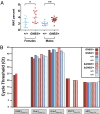Mouse model implicates GNB3 duplication in a childhood obesity syndrome
- PMID: 23980137
- PMCID: PMC3773733
- DOI: 10.1073/pnas.1305999110
Mouse model implicates GNB3 duplication in a childhood obesity syndrome
Abstract
Obesity is a highly heritable condition and a risk factor for other diseases, including type 2 diabetes, cardiovascular disease, hypertension, and cancer. Recently, genomic copy number variation (CNV) has been implicated in cases of early onset obesity that may be comorbid with intellectual disability. Here, we describe a recurrent CNV that causes a syndrome associated with intellectual disability, seizures, macrocephaly, and obesity. This unbalanced chromosome translocation leads to duplication of over 100 genes on chromosome 12, including the obesity candidate gene G protein β3 (GNB3). We generated a transgenic mouse model that carries an extra copy of GNB3, weighs significantly more than its wild-type littermates, and has excess intraabdominal fat accumulation. GNB3 is highly expressed in the brain, consistent with G-protein signaling involved in satiety and/or metabolism. These functional data connect GNB3 duplication and overexpression to elevated body mass index and provide evidence for a genetic syndrome caused by a recurrent CNV.
Conflict of interest statement
The authors declare no conflict of interest.
Figures




References
-
- Feinleib M, et al. The NHLBI twin study of cardiovascular disease risk factors: Methodology and summary of results. Am J Epidemiol. 1977;106(4):284–285. - PubMed
-
- Stunkard AJ, Harris JR, Pedersen NL, McClearn GE. The body-mass index of twins who have been reared apart. N Engl J Med. 1990;322(21):1483–1487. - PubMed
-
- Blakemore AI, Froguel P. Investigation of Mendelian forms of obesity holds out the prospect of personalized medicine. Ann N Y Acad Sci. 2010;1214:180–189. - PubMed
Publication types
MeSH terms
Substances
Supplementary concepts
Grants and funding
LinkOut - more resources
Full Text Sources
Other Literature Sources
Medical
Molecular Biology Databases
Research Materials

